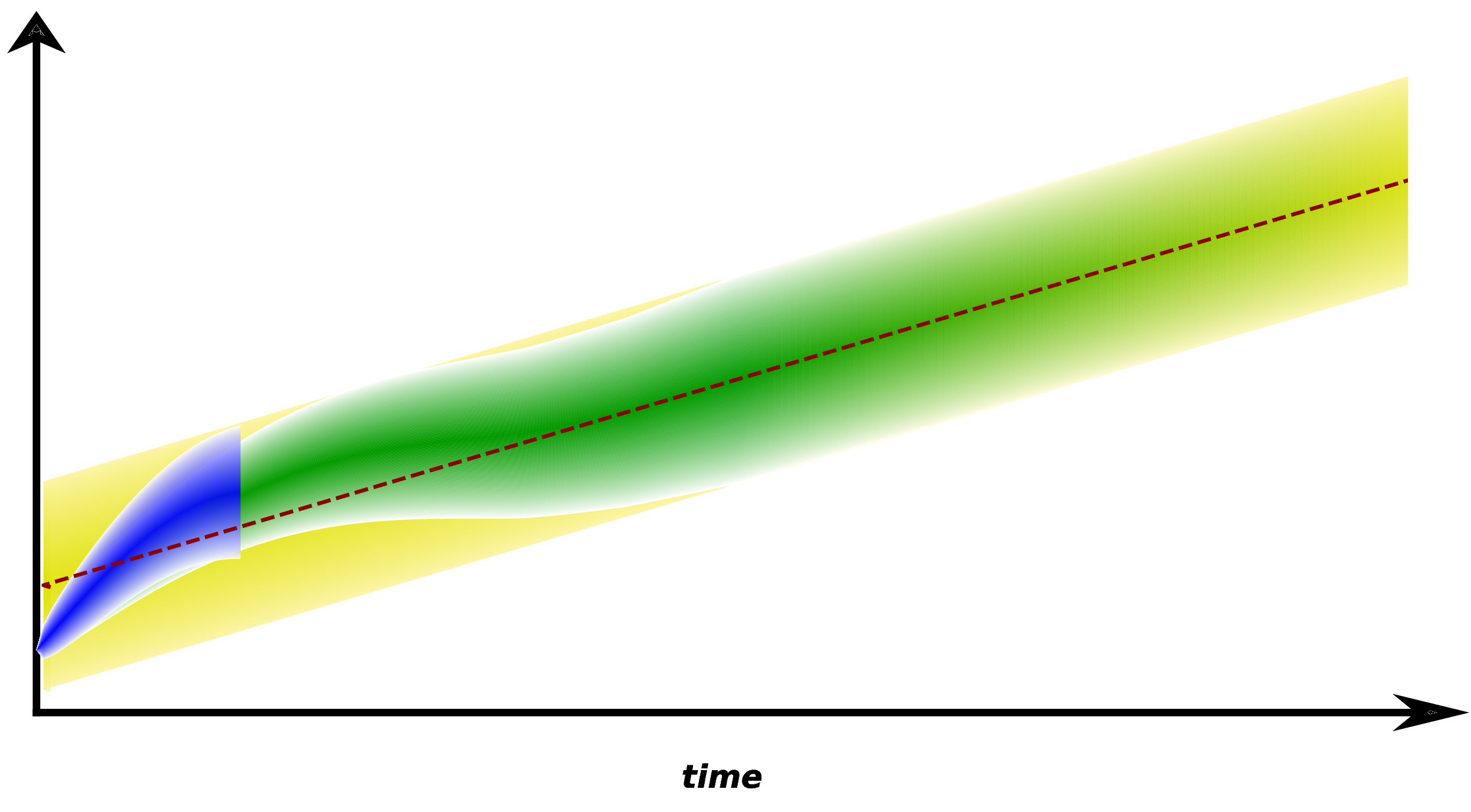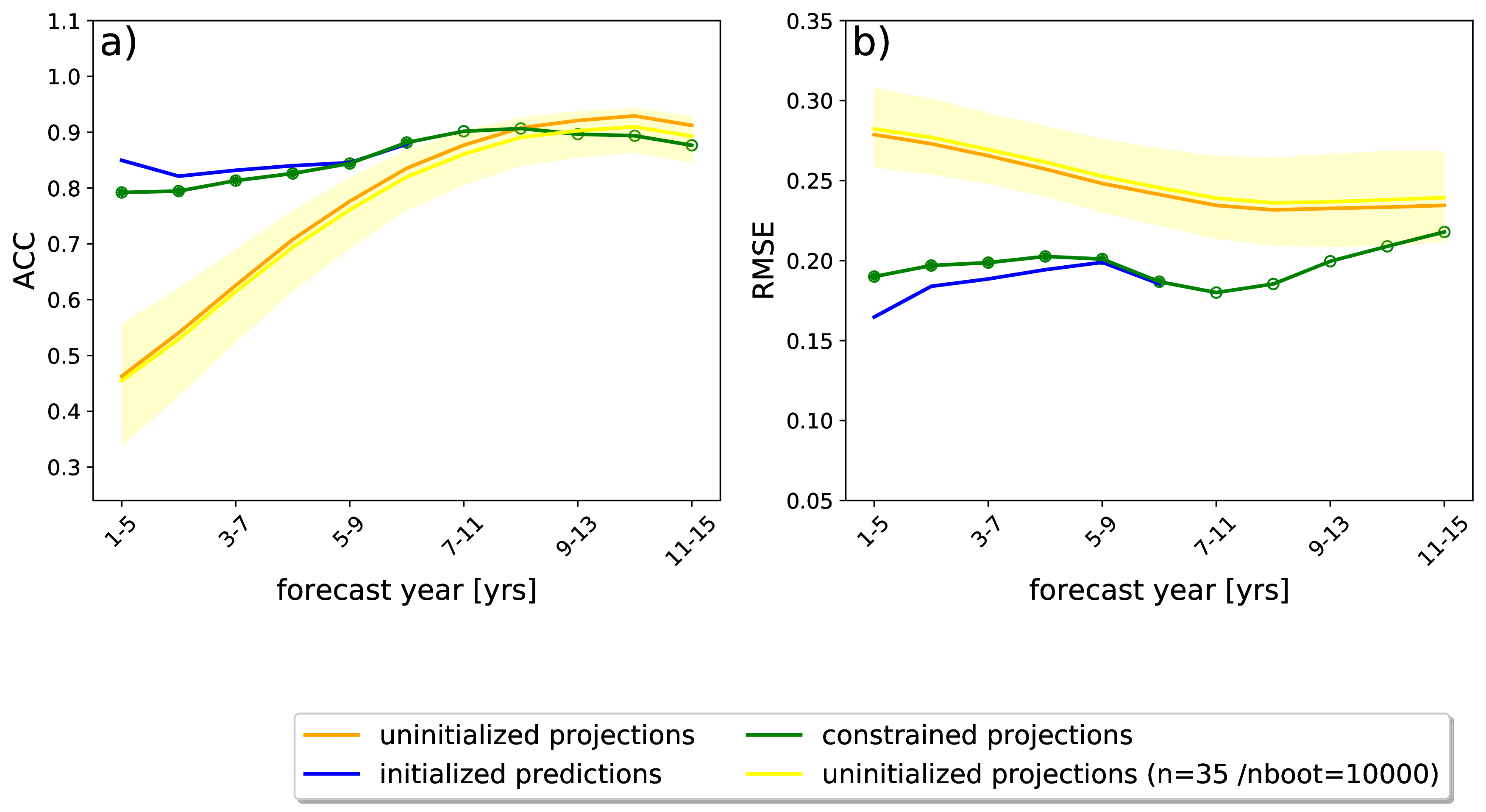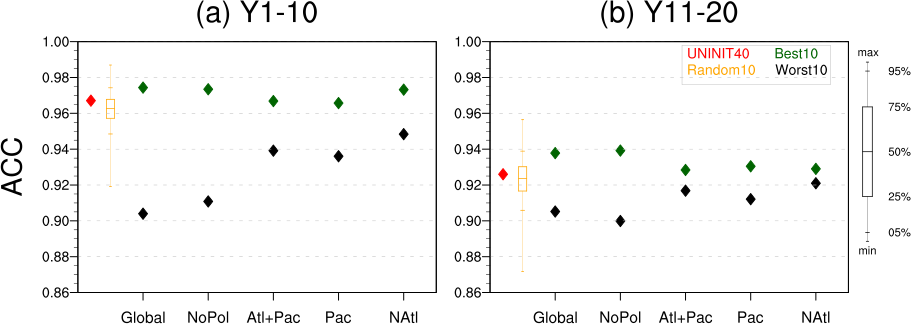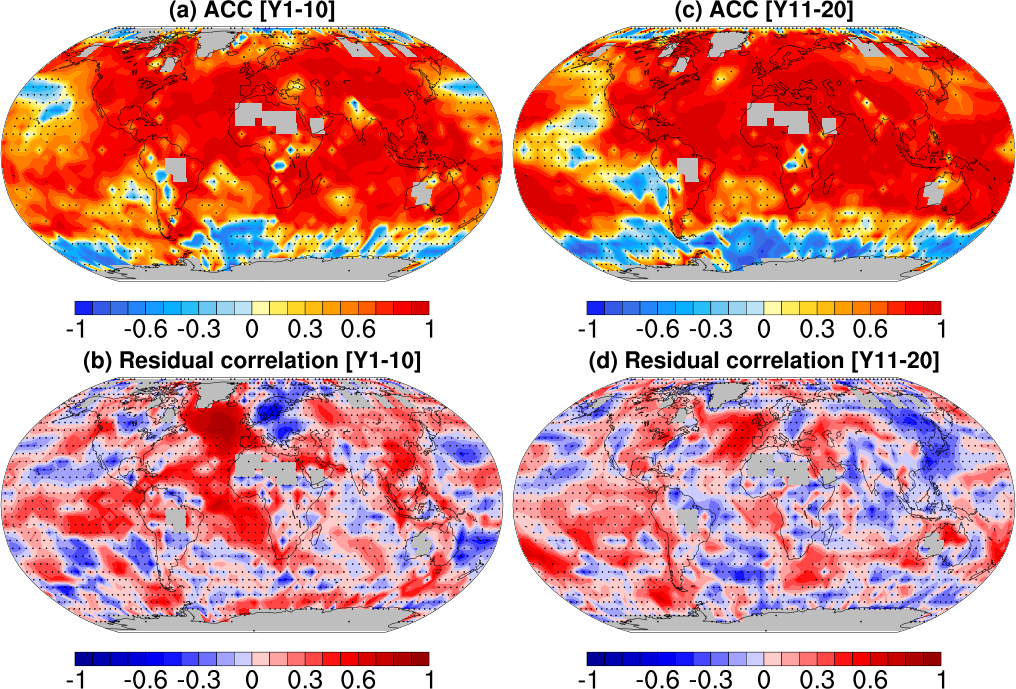Will droughts in 30 years be more intense than today, so that we should adapt our water management plans? Should we plant more heat-resilient trees in our forests? Are our storm water systems prepared for the downpours we expect by 2050? Planning and preparing for near-term climate change requires accurate, reliable and actionable climate information for the upcoming two to four decades. EUCP develops tools and methods to provide the required climate information to enable decision making for adapting to the climate conditions in the decades to come.
Climate information for the next few decades is typically derived from so-called climate projections. These are climate model simulations to assess the climate response to increasing greenhouse gas concentrations over the next century or so. The climate projections are affected by different sources of uncertainty, but the dominating uncertainty for the period of the next few decades is related to the internal variability of the climate system. The world’s oceans are subject to multi-decadal climate variations that modulate the climate in many regions, and the exact climate conditions over the next 20 or 30 years will depend on the phase of these variations. Reducing the uncertainty related to climate variability would therefore improve near-term climate change estimates. Another type of future climate information, so-called decadal predictions, aims to address this problem of uncertainty from climate variations by aligning the climate variability of the climate simulations with the variability of the observed climate. This alignment step is called initialisation to the observed climate state, and the decadal predictions are then typically run for 10 years after initialisation. While it would be theoretically possible to extend the decadal predictions beyond 10 years, these simulations are computationally very expensive, and it is currently unclear to what extent initialisation can add value beyond one decade.
In EUCP we explore whether and to what extent aligning the variability of the climate simulations with the real-world climate can improve climate information beyond the time period covered by decadal predictions. To achieve this, we develop methods to combine the information from decadal climate predictions with climate projections, aiming to provide more accurate quantifications of near-term climate change over the next 10 to 40 years. Two complementary approaches to combine decadal predictions and longer-term climate projections are currently being developed within EUCP.
Constraining climate projections using decadal predictions
The recently published study by Daniel Befort and colleagues from the University of Oxford demonstrated a framework to constrain climate projections using decadal predictions. The underlying hypothesis is that if decadal predictions carry additional information over projections for the next ten years, then these could be used to confine or restrict the full range of the projections, as illustrated in Fig 1. The approach is based on selecting those climate projection ensemble members with the highest agreement with decadal predictions over the first 10 years. The advantage of the constrained projection ensemble over the decadal prediction is that it is not limited to 10 years and thus provides seamless information beyond the range of the decadal predictions.

Figure 1. Schematic illustration of framework to constrain projections (yellow shading) using decadal predictions (blue shading). The constrained projections ensemble based on proximity to the decadal prediction is indicated in green shades. Figure adapted from Befort et al., 2020; their Fig. 1a.
We have tested and validated this framework for near-surface air temperature over the North Atlantic Gyre using past decadal re-forecasts, projections and observations. The North Atlantic has been chosen as a region because this is where initialising CMIP5 climate models adds the most value. Figure 2 shows two measures of skill which evaluate the ensemble means against observations: the anomaly correlation coefficient (ACC) and the root-mean squared error (RMSE). Both measures demonstrate that the constrained sub-ensembles of projections (green) perform better compared to the unconstrained projections (yellow) during the 10 years for which decadal predictions (blue) are available. The constrained projections can outperform the unconstrained projections even beyond 10 years (as seen for the RMSE for forecast years 10 to approx. 15), that is beyond the period when decadal predictions are actively used in the constraint.

Figure 2. a) ACC and b) RMSE for unconstrained projections (black and grey), constrained projections using decadal predictions (green)and decadal predictions (blue) for annual mean surface air temperatures over the North Atlantic Gyre. Statistics are given for five year averages. The yellow area indicates the 10-90% confidence intervals (based on a 10000 sample bootstrap). Figure adapted Befort et al., 2020; their Fig. 3.
Global and regional benefits
But can the combination of decadal predictions and projections also add value to near-term climate change estimates on global scales or in regions where it more directly benefits societies? This question is currently being investigated at the Barcelona Supercomputing Center, using a more global approach to combine the predictions and the projections. They also constrain a large ensemble of climate projections based on the agreement of the different ensemble members with the initialised decadal predictions. Different to the above illustration for the North Atlantic Gyre, this approach measures the agreement of global ocean surface temperature anomaly patterns between the projections and the predictions. Those climate projections most closely resembling the ocean temperature patterns of the decadal predictions are then selected for the constrained sub-ensemble. This approach is illustrated here by using the NCAR Large Ensemble Climate projections consisting of 40 ensemble members (we call them UNINIT40 hereafter) and the decadal predictions also from NCAR’s Decadal Predictions Large Ensemble. Out of the 40 projection members we select the 10 members whose ocean temperature anomaly patterns are most similar (measured by their pattern correlations) to the patterns from the decadal predictions. We call these 10 selected members Best10. To determine the efficacy of this constraint we also consider an ensemble based on the 10 members that show lowest agreement with the decadal predictions, and refer to this as Worst10 in the Figure 3 below. To test the sensitivity of the results to the ocean regions over which the projections are constrained, we use five different spatial domains for measuring the agreement between projections and predictions for the sub-selection (see Figure 3).

Figure 3: Anomaly correlation coefficient (ACC) of the global average sea surface temperature averaged over (a) forecast years 1-10 and (b) forecast years 11-20. Markers show the correlation values for different ensemble means: the full UNINIT40 ensemble, Best10: the sub-selection of the 10 members with best agreement with decadal predictions, Worst10: the 10 members that most disagree with the decadal predictions. The yellow whisker box plot represents a range of ACC values for an ensemble mean of 10 members selected randomly 40,000 times. We tested the Best10 and Worst10 constraints for selections based on different spatial domains: global ocean (Global), global ocean without polar regions (NoPolar), Atlantic and Pacific (Atl+Pac), Pacific (Pac) and North Atlantic (NAtl). Filled markers represent values significant at 95% confidence level. These results are based on constraining using 9 year mean SST.
Our results indicate that selecting those projections that better agree with the decadal predictions can have global effects beyond the first 10 years. Evaluating the skill for (retrospective) predictions of global mean ocean surface temperature, the Best10 sub-ensemble shows higher correlation with observed temperatures than the full UNINIT40 ensemble for predictions of the first and the second 10 years after initialisation of the decadal predictions (note that all correlation values are very high due to the warming trend). This skill improvement is strongest for selections based on global ocean temperature patterns, and global oceans without polar regions. However, regional selections can be preferable when optimising the skill for specific regions. The efficacy of the constraint is further demonstrated by the Best10 ensemble showing consistently higher correlations than the Worst10 ensemble, and selections based on global (and global without polar regions) temperature anomaly patterns perform better than 95 percent of random selections — indicating that these skill improvements are unlikely to be just by chance.
Constraining the climate projections based on their agreement with decadal predictions can also improve regional climate change estimates. The projections show generally positive skill in predicting 10-year averages of near-surface temperatures in most regions apart from the Southern Ocean and parts of the Pacific (Figure 4a, c). Regional improvements in the constrained ensemble depend on the spatial domain used to measure the similarity between projections and decadal predictions. For example, constraining the projections based on North Atlantic ocean surface anomaly patterns, improves the simulated temperatures of the first 10 years primarily in the North Atlantic (Fig. 4b) — the region where decadal predictions also show the largest added skill over projections. A few areas of enhanced skill also remain for the second decade of the retrospective predictions. In the case of constraints based on the North Atlantic domain these improvements are also primarily found in the North Atlantic region including some adjacent continental areas such as Western Europe (see Figure 4d).

Figure 4: Skill of global near-surface temperatures during (a, b) forecast years 1-10 and (c, d) forecast years 11-20. Results in this figure are based on pattern correlations in the North Atlantic domain. (a, c) show the ACC of the retrospective temperature predictions of the constrained ensemble. Stippling indicates where ACC is not significant (p>0.05 based on a t-test). (b, d) show the residual correlations of the predicted anomalies after removing the forced signal derived from UNINIT40, as a measure of added value of the constraint. Stippling indicates where the residual correlation is not higher than 90% of random sub-ensembles based on 40,000 bootstrap realisations.
In summary, these first illustrations of approaches to combine decadal predictions and longer-term climate projections show promising results towards providing improved accuracy of near-term climate change estimates beyond the next decade. Research within EUCP will continue to develop and improve these methods, for example applying them to substantially larger ensembles of climate projections. We hope this has the potential to further narrow the uncertainty of multi-decadal climate information, and possibly enable improved near-term projections of other impact-relevant climate variables and climate extremes.



 Funded by the European Union under Horizon 2020.
Funded by the European Union under Horizon 2020.